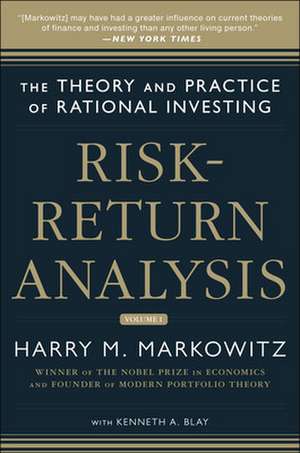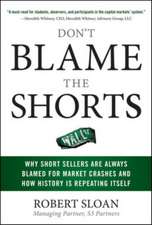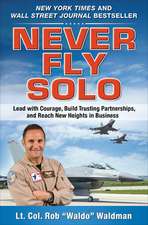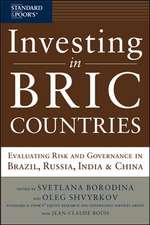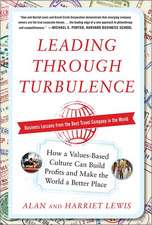Risk-Return Analysis: The Theory and Practice of Rational Investing (Volume One)
Autor Harry Markowitz, Kenneth Blayen Limba Engleză Hardback – 16 oct 2013
Risk-Return Analysis opens the door to agroundbreaking four-book series giving readers a privileged look at the personal reflections and current strategies of a luminary in finance. This first volume is Markowitz's response to what he calls the "Great Confusion" that spread when investors lost faith in the diversification benefits of MPT during the financial crisis of 2008. It demonstrates why MPT never became ineffective during the crisis, and how you can continue to reap the rewards of managed diversification into the future. Economists and financial advisors will benefit from the potent balance of theory and hard data on mean-variance analysis aimed at improving decision-making skills. Written for the academic and the practitioner withsome math skills (mostly high school algebra), this richly illustrated guide arms you with:
- Concrete steps to accurately select and apply the right risk measures in a given circumstance
- Rare surveys of a half-century of literature covering the applicability of MPT
- Empirical data showing mean and riskmeasure used to maximize return in the long term
"Harry Markowitz invented portfolio analysis and presented the theory in his famous 1952 article and 1959 book. Nobody has greater insight into the process than Harry. No academic or practitioner can truly claim to understand portfolio analysis unless they have read this volume." -- Martin J. Gruber, Professor Emeritus and Scholar in Residence, Stern School of Business, New York University
"Surveying the vast literature inspired by [Markowitz's] own 1959 book has stimulated an outpouring of ideas. He builds on the strengths and limitations of the important papers in order to come up with a position that should silence a lot of critics." -- Jack Treynor, President, Treynor Capital Management
"The authors do not overlook various criticisms of the MPT, but rather address them convincingly. This excellent book is an essential reference for academics and practitioners alike." -- Haim Levy, Miles Robinson Professor of Finance, Hebrew University, Jerusalem, Israel
"Markowitz’s groundbreaking publications on Portfolio Selection prescribe a methodology that a rational decision-maker can follow to optimize his investment portfolio in a risky world. . . . Thischallenging new book clarifies many common misconceptions about modern portfolio theory." -- Roger C. Gibson, author of Asset Allocation and Chief Investment Officer, Gibson Capital, LLC
"Contain[s] great wisdom that every economist, portfolio manager, and investor should savor page by page." -- Andrew W. Lo, Charles E. and Susan T. Harris Professor and Director, Laboratory for Financial Engineering, MIT Sloan School of Management
"[Markowitz's] monumental work in the 1950s would be sufficient to qualify as a lifetime achievement for most mortals, but he keeps spouting fresh insights like lightning flashes year after year, and penetrating ever deeper into the theory, mathematics, and practice of investing." -- Martin Leibowitz, Managing Director, Global Research Strategy, Morgan Stanley
"Risk–Return Analysis is a wonderful work in progress by a remarkable scholar who always has time to read what matters, who has the deepest appreciation of scientific achievement, and who has the highest aspirations for the future." -- Enterprising Investor (CFA Institute)
Preț: 319.33 lei
Preț vechi: 396.49 lei
-19% Nou
Puncte Express: 479
Preț estimativ în valută:
61.11€ • 64.01$ • 50.64£
61.11€ • 64.01$ • 50.64£
Carte tipărită la comandă
Livrare economică 10-16 aprilie
Livrare express 04-08 martie pentru 69.01 lei
Preluare comenzi: 021 569.72.76
Specificații
ISBN-13: 9780071817936
ISBN-10: 007181793X
Pagini: 272
Dimensiuni: 165 x 236 x 23 mm
Greutate: 0.53 kg
Editura: McGraw Hill Education
Colecția McGraw-Hill
Locul publicării:United States
ISBN-10: 007181793X
Pagini: 272
Dimensiuni: 165 x 236 x 23 mm
Greutate: 0.53 kg
Editura: McGraw Hill Education
Colecția McGraw-Hill
Locul publicării:United States
Cuprins
Foreword xi
Preface xxi
Acknowledgments xxvii
Outline of Plans for Volumes II, III, and IV xxix
1. The Expected Utility Maxim 1
Introduction 1
Defi nitions 5
Uniqueness 10
Characteristics of Expected Utility Maximization 12
RDMs Versus HDMs 14
Allais’s Paradox 17
Weber’s Law and the Allais Paradox 21
The Axioms 24
Axiom I 25
Axiom II 26
Axioms III and III¿ 28
Bounded Versus Unbounded Utility of Returns 31
Postscript 34
2. Mean-Variance Approximations to Expected Utility 37
Introduction 37
Why Not Just Maximize Expected Utility? 41
Utility of Return Versus Utility of Wealth 44
Loistl’s Erroneous Analysis 47
Levy and Markowitz (1979) 48
Highly Risk-Averse Investors 53
Highly Risk-Averse Investors and a Risk-Free Asset 56
Portfolios of Call Options 58
Ederington’s Quadratic and Gaussian Approximations to Expected Utility 63
Other Pioneers 69
Conclusion 72
3. Mean-Variance Approximations to the Geometric Mean 73
Introduction 73
Why Inputs to a Mean-Variance Analysis Must Be Arithmetic Means 78
Six Mean-Variance Approximations to g 80
Observed Approximation Errors for Asset Classes 84
Relationships Among Approximation Methods 90
Twentieth-Century Real Equity Returns 97
Choice of Approximation 111
Recap 117
Technical Note: Selecting a Weighted Average of Approximations 118
4. Alternative Measures of Risk 123
Introduction 123
The Asset-Class Database 124
Comparisons 127
The DMS Database 137
Caveat and Conclusion 147
5. The Likelihood of Various Return Distributions (With Anthony Tessitore, Ansel Tessitore,and Nilufer Usmen) 149
Introduction 149
Bayes Factors 153
Transformed Variables 156
Compound Hypotheses 159
The Pearson Family 161
The DMS Database 169
Practically Normal Distributions 175
Illustrative Histograms 179
Near LH-Maximizing Distributions for the Ensemble 182
Transformed Country Distributions 186
Observations 190
Recommendation 192
Notes 195
References 209
Index 217
Preface xxi
Acknowledgments xxvii
Outline of Plans for Volumes II, III, and IV xxix
1. The Expected Utility Maxim 1
Introduction 1
Defi nitions 5
Uniqueness 10
Characteristics of Expected Utility Maximization 12
RDMs Versus HDMs 14
Allais’s Paradox 17
Weber’s Law and the Allais Paradox 21
The Axioms 24
Axiom I 25
Axiom II 26
Axioms III and III¿ 28
Bounded Versus Unbounded Utility of Returns 31
Postscript 34
2. Mean-Variance Approximations to Expected Utility 37
Introduction 37
Why Not Just Maximize Expected Utility? 41
Utility of Return Versus Utility of Wealth 44
Loistl’s Erroneous Analysis 47
Levy and Markowitz (1979) 48
Highly Risk-Averse Investors 53
Highly Risk-Averse Investors and a Risk-Free Asset 56
Portfolios of Call Options 58
Ederington’s Quadratic and Gaussian Approximations to Expected Utility 63
Other Pioneers 69
Conclusion 72
3. Mean-Variance Approximations to the Geometric Mean 73
Introduction 73
Why Inputs to a Mean-Variance Analysis Must Be Arithmetic Means 78
Six Mean-Variance Approximations to g 80
Observed Approximation Errors for Asset Classes 84
Relationships Among Approximation Methods 90
Twentieth-Century Real Equity Returns 97
Choice of Approximation 111
Recap 117
Technical Note: Selecting a Weighted Average of Approximations 118
4. Alternative Measures of Risk 123
Introduction 123
The Asset-Class Database 124
Comparisons 127
The DMS Database 137
Caveat and Conclusion 147
5. The Likelihood of Various Return Distributions (With Anthony Tessitore, Ansel Tessitore,and Nilufer Usmen) 149
Introduction 149
Bayes Factors 153
Transformed Variables 156
Compound Hypotheses 159
The Pearson Family 161
The DMS Database 169
Practically Normal Distributions 175
Illustrative Histograms 179
Near LH-Maximizing Distributions for the Ensemble 182
Transformed Country Distributions 186
Observations 190
Recommendation 192
Notes 195
References 209
Index 217
